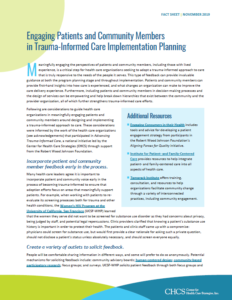
Meaningfully engaging the perspectives of patients and community members, including those with lived experience, is a critical step for health care organizations seeking to adopt a trauma-informed approach to care that is truly responsive to the needs of the people it serves. This type of feedback can provide invaluable guidance at both the program planning stage and throughout implementation. Patients and community members can provide first-hand insights into how care is experienced, and what changes an organization can make to improve the care delivery experience. Furthermore, including patients and community members in decision-making processes and the design of services can be empowering and help break down hierarchies that exist between the community and the provider organization, all of which further strengthens trauma-informed care efforts.
This fact sheet outlines considerations to guide health care organizations in meaningfully engaging patients and community members around designing and implementing a trauma-informed approach to care. These considerations were informed by the work of the health care organizations (see acknowledgements) that participated in Advancing Trauma-Informed Care, a national initiative led by the Center for Health Care Strategies through support from the Robert Wood Johnson Foundation.